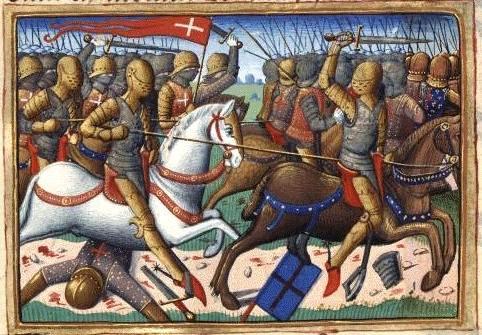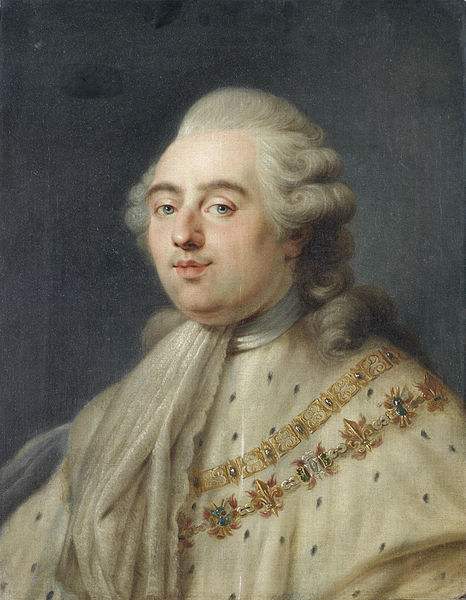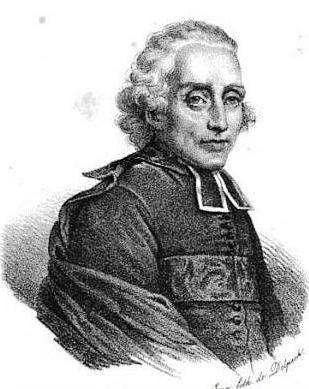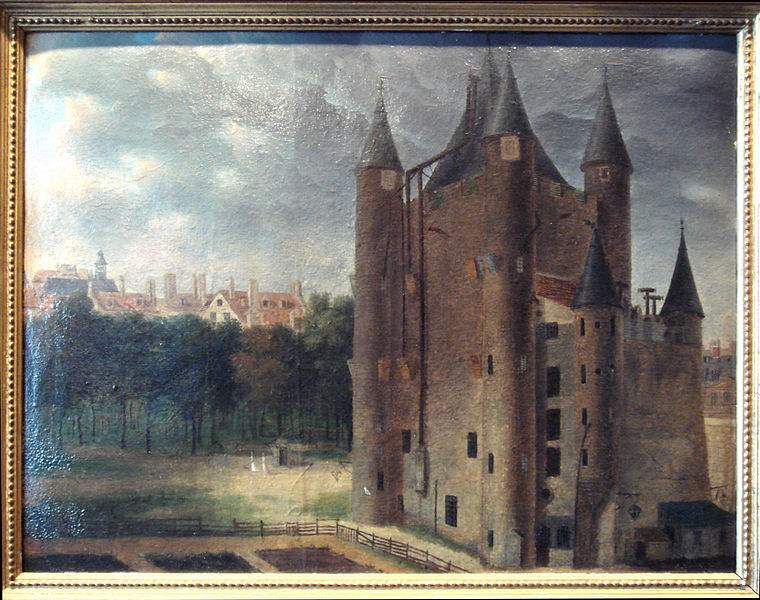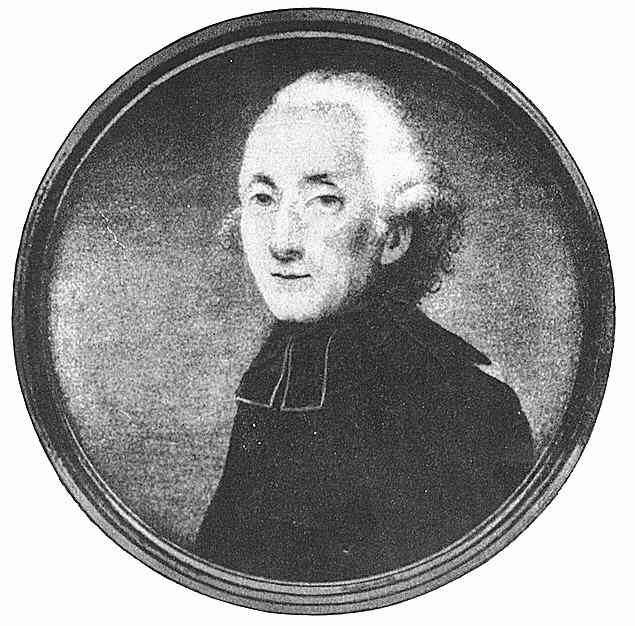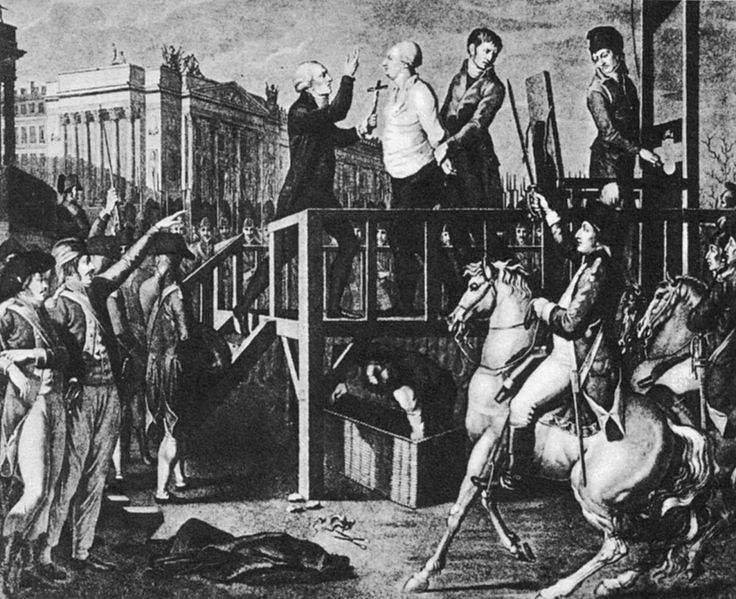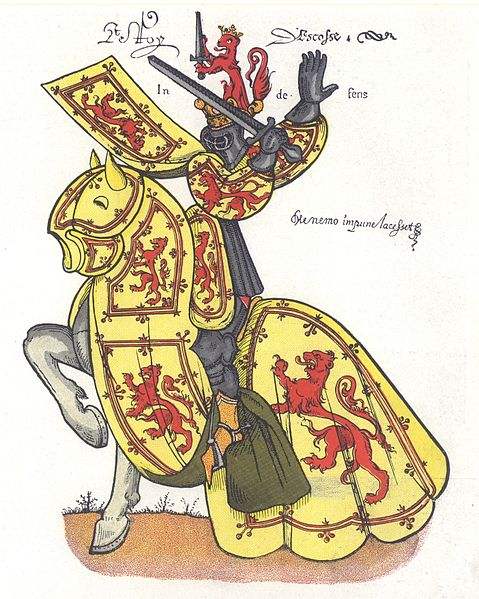
A 15thC armorial depiction of the King of Scots, showing the arms of William the Lion, as adopted by Scotland’s later kings who added the tressure featuring the French fleur-de-lys symbolising the traditional Franco-Scottish alliance against England. Below the title ‘Le Roy d’Escosse’ appear the mottoes of the Royal Stewart kings of Scotland: ‘In defens’ and ‘Me nemo impune lacessit’, “No one attacks me with impunity”.
Among the singularities of the French monarchy was the tradition of having Scottish bodyguards. Scottish history has not been riddled with pacifism, and the Scots along with the fiery Castilians, were used as mercenaries as early as Charlemagne. An “Auld Alliance” between Scotland and France was sealed in 1295, and in the dark war days of 1942, Charles de Gaulle invoked it as “the oldest alliance in the world.” In 1418, as Charles VI began to go mad, the Dauphin called on Scottish troops to support his cause against Henry V. They were victorious at the battle of Baugé in 1421, prompting Pope Martin V to comment: “The Scots are well known as an antidote to the English.” St. Joan of Arc entered besieged Orleans in 1429 with a retinue of 130 Scots guards protecting her and playing on bagpipes the same tune, “Hey Tuttie Taiti,” that had been played for Robert the Bruce at the Battle of Bannockburn a century before. The guards and pipers were also present with Joan at the coronation of the Dauphin as Charles VII at Rheims. The new king chose one hundred of the Scots as his personal bodyguards to honor their heroism when 6,000 of their number died at the Battle of Verneuil in 1424. The “Garde Ecossaise” later became “Garde de la Manche” since they escorted the king close enough to be touched by his sleeve.
By the eighteenth century, some of them were more French than Scottish but they wore the thistle and carried claymore with basket guards of steel, guarding the French kings until Charles X abdicated in the July Revolution of 1830. They served as a poignant reminder of the Auld Alliance that lasted until 1906, and as late as then, anyone born in Scotland could have dual citizenship with France.
This recalls another Celtic curiosity: the priest who accompanied King Louis XVI to his execution was Irish. Rarely does anyone ask why the French king had an Irish confessor. Like the Garde Ecossaise, there is of course an explanation, and an edifying one at that.
Henry Essex Edgeworth was born in County Longford at Firmount, the ancestral home of the Edgeworths who had come from Middlesex, England during the reign of Elizabeth in 1582. In their house, Oliver Goldsmith had learned to read and write. Some accounts claim Henry as a great great grandson of the third cousin of Archbishop James Ussher, the seventeenth century Anglican Primate of Ireland who was a first rate classicist but a less distinguished historian, as he used the date of King Nebuchadnezzar’s death to calculate that the world was created on October 23, 4004 BC. His contemporary, John Lightfoot, Vice-Chancellor of Cambridge University, outdid him by dating the expulsion of Adam and Eve from Eden at 10 AM on Monday, November 10 in the same year. Just as Edgeworth eventually would do, Ussher consoled his sovereign Charles I in prison during his last night on earth in 1649 and accompanied him to his execution but fainted before the axe was brought down.
Henry’s mother, Martha, was the daughter of Christopher Ussher of Wicklow, an unyielding Protestant who wrote in his Last Will: “My daughters Catherine Ussher and Martha Edgeworth are turned Roman Catholiques and have quitted me and my family and all natural ties to them and their country. I leave them one shilling each, with my blessing.” Henry’s father Robert was an Anglican clergyman whose own family was not unfriendly to Catholics. One of them recalled: “The Roman Catholic Bishop M‘Gaurin, held a Confirmation the day before yesterday, and dined here on a God-send haunch of venison.” The Reverend Robert Edgeworth made an intense profession of the Catholic Faith and left the Penal Laws behind for France with his wife, his sister-in-law Catherine, and his youngest son Henry who began studies in Toulouse and eventually was ordained in Paris. He had hoped to become a foreign missionary and lived at the residence of Les Missions Etrangers, working with all ranks of the agitated populace, gaining a great following among the poorest, and counseling expatriate English and Irish, converting some Protestants among them. He chose not to accept the offer of a bishopric back in Ireland, so that he might minister to the poor Savoyards of Paris. At the outbreak of the Revolution, the Archbishop of Paris, Monsignor Antoine Le Clerc, de Juigné nominated him as confessor to Madame Elizabeth, the sister of Louis XVI and he visited her frequently in prison.
His mother and sister joined him in Paris, his mother eventually dying in captivity while his sister died later. The Archbishop gave the Abbé Henri Essex Edgeworth de Firmont the title Grand Vicaire, with responsibility for all the Catholics of Paris, and fled for is own life to Germany. An aunt in Galway asked him to flee and be her chaplain, as she had also become Catholic, but he used as an excuse that his English had become poor after many years abroad. A letter to a priest in London told the truth:
Almighty God has baffled my measures, and ties me to this land of horrors by chains I have not the liberty to shake off. The case is this: the wretched master [the King] charges me not to quit this country, as I am the priest whom he intends to prepare him for death. And should the iniquity of the nation commit this last act of cruelty, I must also prepare myself for death, as I am convinced the popular rage will not allow me to survive an hour after the tragic scene; but I am resigned. Could my life save him I would willingly lay it down, and I should not die in vain.
The evening before January 21, 1793, the Abbé fell in tears at the King’s feet. Louis helped him up, made his last confession and then bade farewell to the Queen and their children. The Commune having reluctantly allowed the Abbé to put on vestments, as clerical dress had been forbidden, he said Mass and gave the King his last Communion. The two stayed together until dawn:
The King, finding himself seated in the carriage, where he could neither speak to me nor be spoken to without witness, kept a profound silence. I presented him with my breviary, the only book I had with me, and he seemed to accept it with pleasure: he appeared anxious that I should point out to him the psalms that were most suited to his situation, and he recited them attentively with me. The gendarmes, without speaking, seemed astonished and confounded at the tranquil piety of their monarch, to whom they doubtless never had before approached so near….
In one of his last gestures, the King placed his hand on Edgeworth’s knee and then told the guard to take care of his priest. Louis appeared shocked when the guards began to bind his hands. Edgeworth told him: “Suffer this outrage, as a last resemblance to that God who is about to be your reward.” The youngest of the executioners, eighteen years old, held the King’s head high and let some of the blood splatter on the Abbé. He slipped through the crowd: “All eyes were fixed on me, as you may suppose; but as soon as I reached the first line, to my surprise, no resistance was made…. I was not permitted, on this occasion, to wear any exterior marks of a priest. I was absolutely lost in the crowd, and no more noticed than if I had been a simple spectator of a scene which forever will dishonour France.”
The Abbé first took refuge in the Rue du Bac where the Blessed Mother would appear to Catherine Labouré in 1830. After a stay in Bayeux, he crossed to England in 1796 and went to Scotland to see the King’s brother, the comte d’Artois. Prime Minister Pitt offered him a large pension which he accepted, though he declined the presidency of Maynooth seminary and honors from King Louis XVIII. He joined the exiled household of Louis in Blankenberg and moved with them to Mittau in Russia. Louis delegated him to go to St. Petersburg and present the Order of the Holy Spirit to Czar Paul who, moved by the transparent piety of Edgeworth, knelt and begged his blessing. Back in Mittau he contracted typhus from nursing sick French soldiers stranded during the Napoleonic campaign. Risking contagion, the Princess Marie-Therese, daughter of Louis XVI, attended the deathbed of the “beloved and revered invalid, her more than friend, who had left kindred and country for her family.”
The Abbé Edgeworth never claimed to have said the words ascribed to him as the King climbed the steps to the guillotine, and many suppose they were as apocryphal as Newton’s apple or the three hundred Spartans who stopped the army of Xerxes, but they were dear to Macaulay: “Montez au ciel, fils de Saint Louis. Climb up to heaven, son of Saint Louis.”
Louis XVIII did him the rare honor of personally composing his epitaph, and in splendid Latin, too:
Here lies the Very Reverend Henry Essex Edgeworth de Firmont, a priest, of the Holy Church of God: Vicar General of the Diocese of Paris, etc., Who following in the steps of our Redeemer, was an Eye to the Blind, a Staff to the Lame, a Father to the Poor, and a Consoler of the Afflicted. When Louis XVI was delivered over to Death by his impious and rebellious subjects, he gave the resolute Martyr strength for his last struggle and pointed out to him the opening Heavens. Snatched from the hands of regicides by the wonderful protection of God, he voluntarily attached himself to Louis XVIII, when he signified his wish for his services To whom and to whose Royal Family and Faithful Comrades, he proved himself for a space of ten years, an example of Virtue and an Assuager of misfortune. Driven from kingdom to kingdom by the calamity of the times, he went about doing good, ever like to Him who possessed his sole devotion. At length full of good works, he died the 22nd May, the year of our Lord, 1807, aged 62. May he rest in peace.
Short Stories on Honor, Chivalry, and the World of Nobility—no. 318
Reprinted with permission from Crisis Magazine, May 15, 2013
